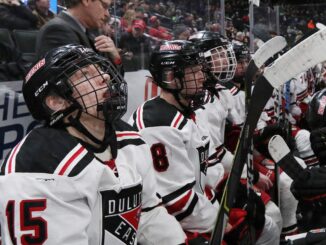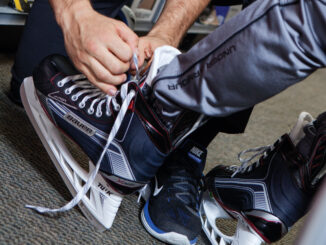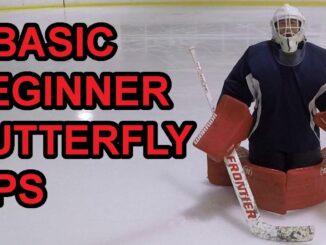
Injuries are a part of sport and hockey goalies are not immune. For hockey goalies the meniscal tear can have an impact on performance and may also have an impact on your other daily activities. Let’s look at the symptoms of meniscal tears, the mechanisms of meniscal tear and what you can do to prevent or recover from this injury.
The hinge joint of your knee is comprised of the femur (thigh bone) and the tibia (shin bone). The end of the femur is somewhat rounded like a knuckle, where the tibial plateau is relatively flat. The knee is not the most stable joint so the menisci (you have two – one medial and one lateral) help give a little more depth to the joint surfaces and they provide a little cushion between the femur and tibia.
The menisci are shaped a little like a hockey puck that has been squished a little in the middle. It is a cartilaginous material and the big problem with meniscal tears is the fact that the meniscus has a poor blood supply. The outer rim of the meniscus has some blood supply, so a tear in this area may actually heal. As you move toward the centre of the meniscus there is very little or no blood supply, so tears in this area will not heal.
When I worked as the exercise specialist at a sport medicine clinic, one of the physiotherapists had an awesome analogy for what meniscal tears are and what they feel like. She described a meniscal tear as a ‘hang nail’ in your knee. You know how you can have a hang nail and it typically feels just fine, not painful at all – until you catch that little flap of skin going against the grain. When that happens – WOW! Look out; major pain.
Hockey goalies who have a meniscal tear may be just fine to complete all activity they wish, but then they may go to walk around a corner or drop into your butterfly and – ouch! The knee may even give away from the jolt of pain. If you feel a general ache under your knee cap, this is likely something more like a patellofemoral irritation than a meniscal tear.
The tricky thing about meniscal tears is that there are numerous mechanisms. I remember one individual who spent an afternoon kneeling on their knees while refinishing a floor and when they went to stand up – yikes – meniscal tear. But for hockey goalies I think there are two common mechanisms.
- There is a collision between a skater and a goalie in which the skater falls on the goalie’s knee when it is in a flexed position or the goalie is driven backward with their foot trapped beneath them.
- The goalie moves into a position where the knee is put under a medial/lateral (varus or valgus) stress and they put stress on the meniscus which overtime or in one instant may cause a meniscal irritation or tear. I am thinking particularly of the butterfly position for goalies.
The goalie will feel pain at the time of injury and there may be some swelling in the knee. If you think you have torn your meniscus, then start with rest, ice and elevation. It may settle down. If your knee is locked, i.e. you physically cannot strengthen it or trying to do so leads to major pain, then you should head straight to the phone and call your local sport medicine professional.
If you have torn your meniscus, you should get some physiotherapy from a good sport physiotherapist. If it is a severe tear you may need to consult an orthopedic surgeon who may either scope the knee to remove some of the rough edges and ‘clean’ things up a little. If it is a large tear toward the inner portion of the meniscus the surgeon may decide to stitch it back together which helps preserve the meniscus which over time will greatly reduce the wear and tear on the knee over time.
Whether you have injured your meniscus in the past or if you are a hockey goalie looking to reduce the risk of injury, the fundamentals are the same. As long as you are symptom free then you should be sure to include work on your hip internal rotation so you can get into your butterfly by getting range from the hip, not by torquing through the knee.
Unless otherwise stated, PONIREVO and/or its licensors DO NOT own any intellectual property rights in the website and material on the website. Majority of the site’s content has been scraped and auto posted by a third party artificial intelligence program —– PONIREVO Creation Team.
Proudly WWW.PONIREVO.COM



